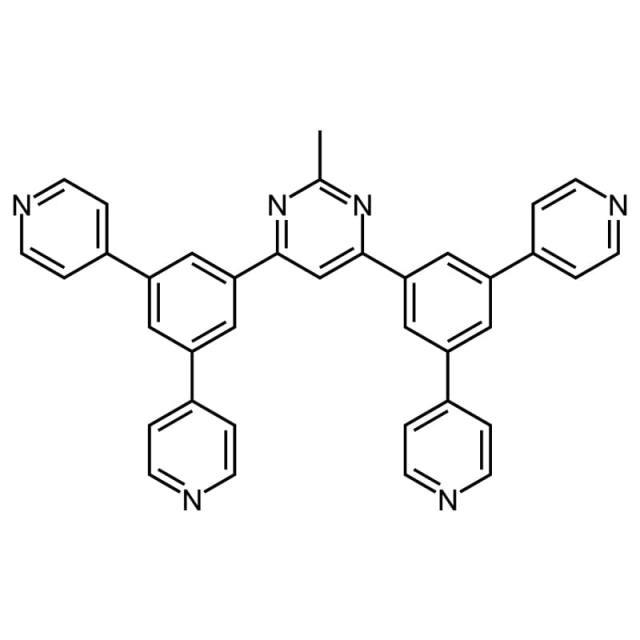The content on our website is provided solely for general informational purposes. It should not be considered, nor is it intended to provide advice or recommendations for the purchase, sale, or trade of any products or services. Importantly, the information presented does not constitute an offer to sell or a solicitation of an offer to buy any product.
Please be aware that the availability of our products may vary across different markets due to regulatory restrictions or other considerations. Consequently, not all products or services may be available in your region or country. For specific inquiries regarding the availability and pricing of any product, please contact us at sales@noctiluca.eu.
General information
-
Name:
B4PymPm
-
Full name:
4,6-Bis(3,5-di(pyridin-4-yl)phenyl)-2-methylpyrimidine
-
CAS number:
1030380-51-8
-
Chemical formula:
C37H26N6
-
Molecular weight:
554.64 g/mol
-
Absorption:
λmax = 250 nm in DCM
-
Photoluminescence:
λmax = 410 nm in film
-
HOMO/LUMO:
N/A
-
Synonyms:
4,6-Bis(3,5-di-4-pyridinylphenyl)-2-methylpyrimidine
-
Classification:
Organic light-emitting diodes, Electron transport layer materials (ETL), Electron injection layer materials (EIL), Hole blocking layer materials (HBL), Emmiting layer materials (EML), Host materials, Solar cells, TADF materials
-
Purity:
Sublimed: >99.0% (HPLC)
-
Melting point:
374 °C
-
Appearance:
White powder/crystals
B4PymPm Specification: The Apex of OLED Advancements
The ever-expanding domain of organic light-emitting diodes (OLEDs) is propelled by a diverse array of materials and compounds. Among these, B4PymPm—fully known as 4,6-Bis(3,5-di(pyridin-4-yl)phenyl)-2-methylpyrimidine—emerges as a pivotal element in the OLED technology stack.
Understanding B4PymPm
B4PymPm is a heterocyclic organic compound distinguished by its unique molecular structure. B4PymPm is a structural isomer of B2PymPm and B3PymPm and it features a central 2-methylpyrimidine core and is adorned with four pyridine appendages. This compound holds particular significance in the field of organic electronic devices, including OLEDs.
Key Features of B4PymPm
- Electron Transport Material: Owing to its donor-acceptor configuration, B4PymPm serves as an exemplary material in electron transport layers or hole blocking layers. This ensures that OLEDs function with optimal efficiency and possess extended lifetimes.
- High Thermal Stability: The compound’s elevated thermal stability and glass transition temperature render it suitable for high-performance optoelectronic devices, thereby contributing to their longevity.
- Versatile Applications: Beyond its role in OLEDs, B4PymPm finds applications in various other optoelectronic devices, such as organic solar cells and field-effect transistors, further attesting to its versatility.
The Role of B4PymPm in Contemporary OLEDs
In the current landscape of OLED technology, the demand for materials that offer elevated efficiency, durability, and reduced energy consumption is incessant. B4PymPm, with its multifaceted properties, aligns seamlessly with these prerequisites. Its efficient charge transport capabilities and high thermal stability ensure not only optimal functionality but also an extended lifespan for OLEDs.
Conclusion
The OLED sector is in a constant state of evolution, driven by the imperative for materials that are both efficient and durable. B4PymPm, endowed with a unique set of properties and functionalities, is poised to play a substantial role in shaping the future of OLED technology. As research advances and technology matures, B4PymPm is anticipated to find an expanding array of applications in organic electronic devices.
